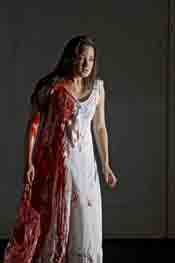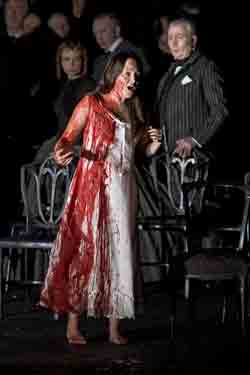Recently in Performances
Director Jonathan Miller was there at the curtain call to greet the first night of this latest revival of a production which has now been in ENO's repertoire for twenty years.
My Valentine’s Day gift came a bit early courtesy of Los Angeles Opera. Of course, it is to be hoped that your own celebration has a happier outcome than that of opera’s most famous Love Couple, “Tristan und Isolde.”
Valentine’s Day may not quite be in the same major holiday league with the Fourth of July or New Year’s Eve, but you wouldn’t have known it from the fireworks emanating from the stage of Portland Opera, in the form of some dazzling Valentine’s night vocalizing in quite a fine production of Handel’s “Rodelinda.”
A sound designer? Isn’t that merely a euphemistic upgrade of “sound engineer?”
An air of anticipation filled the Four Seasons Centre as the announcer walked across the stage to say that soprano Ester Sümegi was ill and would not be performing.
To open its 2008 season, San Diego Opera restored the production of Richard Wagner's Tannhäuser that Günther Schneider-Siemsson created for the Metropolitan Opera three decades ago.
Anthony Minghella's visually-arresting staging, a co-production with New York's Metropolitan Opera and the Lithuanian National Opera, returned this month to its original home at the London Coliseum after a gap of two years.
While I eagerly seized upon an opportunity to hear Angelika Kirschlager live for the first time, having written in very recent weeks about not one but two of the star mezzo’s current CD releases, I ventured to Frankfurt’s Alte Oper feeling a little bit like her stalker.
When I worked in the Archives of the Met, I was custodian of several hundred costumes, many from the days when divas traveled with steamer trunks full of things run up just for them, by the finest designers, with the most glamorous materials, in the colors and styles that suited the ladies themselves.
There is nothing redeeming about Sir John Falstaff, one of Shakespeare’s most lively comic characters and the subject of Verdi’s final opera, and yet, inexplicably, we love him.
What constitutes an “international opera star” these days, anyway?
The Metropolitan Opera audience loves its Wagner, and the management for the last several decades has, alas, made sure we aren’t spoiled: it’s a rare season that gets more than two production revivals of Wagner, and some years there have been none.
With her performance of the “Four Last Songs,” ably partnered by Michael Tilson Thomas and his San Francisco Symphony, Deborah Voigt emphatically confirmed her place as one of the glories of the current roster of Strauss interpreters.
John Adams, whose opera Nixon in China set the bar for post-minimalism in the lyric theatre, has once again scored a success with his latest work.
Wagner’s all-conquering chic made apocalyptic music-dramas drawn from folklore the ideal of the nationalistic era; every serious opera composer of the time felt obliged to attempt something in that line.
In this country art and politics are rarely bedfellows — strange or otherwise; indeed, it’s seldom that the two meet under the same roof.
Regarded, until the modern vogue for earlier masters, as the senior surviving grand master of opera, Gluck never quite becomes fashionable and never quite vanishes.
There is no middle ground in War and Peace — or, rather, it’s all middle ground, like a battlefield, and you may feel as if every soldier in Russia (and in France) has marched over you.
Once upon a time, we used to only dream about a stellar pairing like Barcelona’s Gran Teatre del Liceu has fielded for their current offering on display: “La Cenerentola.”
At the curtain call for the first night of WNO’s new production of the infrequently performed Khovanshchina director David Pountney wore a simple Russian shirt.
Performances

20 Feb 2008
Anna Christy Triumphs in Lucia di Lammermoor at ENO
ENO doesn’t really go in for bel canto opera. Other than a Maria Stuarda back in the mid 1990s, the only Donizetti opera in the company’s repertoire in the recent past has been the popular L’elisir d’amore.
Dramatically, Lucia di Lammermoor is perhaps the composer’s finest work, and one of the most obvious precursors to Verdi, but it’s also one of the most problematic to cast, not least because of its daunting historical association with some of the greatest sopranos and tenors of the twentieth century.
If any opera company can be relied upon to make a credible ensemble piece of an opera that’s known for being a star vehicle, it’s ENO, and this first new production of 2008 is a triumph. It may not be orchestrally thrilling — Paul Daniel’s conducting doesn’t really allow any rhythmic variation or space, at least for the first two acts — but the staging is dramatic, emotionally involving and coherent, and the principal casting is almost faultless. All did not go entirely to plan on opening night; singing the chaplain Raimondo, Clive Bayley succumbed to a chest infection part-way through the first act and he continued to mime the role to the voice of his cover, Paul Whelan, who is due to sing two scheduled performances of his own at the end of the run, but who on this occasion sang from one side of the proscenium.
In David Alden’s bleakly monochromatic production, with sets by Charles Edwards and costumes by Brigitte Reiffenstuel, emotion takes second place to practical and political considerations. A fixation with the past — particularly childhood, and images of dead ancestors — prevents anybody from influencing their own future or bringing anything interesting or new into their lives. It has turned Enrico into a bitter, almost emotionless shell, with a perverse obsession with his naïve young sister, whom he keeps trapped in childhood before brutally ’breaking her in’ and throwing her into her unwanted marriage to Dwayne Jones’s soulless pretty-boy Arturo. Mark Stone’s sense of bel canto legato leaves something to be desired, but the darkness in his voice makes his Enrico deeply nasty.
Edgardo is really no better. While Enrico’s reaction to his surroundings and the events of his past have turned him introverted and cruel, Edgardo has become careless, rash and impetuous, which ultimately makes him almost as responsible for Lucia’s fate as her brother. Barry Banks’s vocal and dramatic power belie his small stature; his presence is easily a match for Stone’s, and his final aria sequence is thrillingly, beautifully sung.
 The Mad Scene (Anna Christy in foreground)
The Mad Scene (Anna Christy in foreground)
In the tile role, Anna Christy’s remarkable physical portrayal and crystalline soprano — not audibly marred by the bronchitis which had prevented her from completing the dress rehearsal — make her utterly convincing as this troubled, abused young girl. There is something other-worldly about her voice, and its partnership with the glass harmonica (restored to the Mad Scene as Donizetti intended) creates a chilling resonance. Although the libretto refers to her passionate nature, passion is lacking; she is more of a dreamer. We first see her perched at one side of a miniature stage, gazing obliquely at the closed curtain; she is discovered there again following Raimondo’s revelation that she has murdered Arturo, and during the mad scene, after the curtain is pulled back to reveal her husband’s bloodied body, she gradually retreats into the “stage” area as if it is the realisation of a long-held dream.
Tellingly, the blood which drenches Lucia’s and Arturo’s wedding-night garb is almost the first colour that’s been onstage all evening; it serves as both a coup de theatre and a symbol of Lucia’s release through madness from the bonds of her dead, grey, repressed surroundings.
Ruth Elleson © 2008

